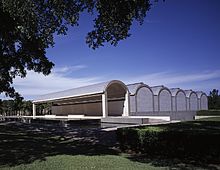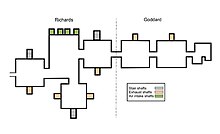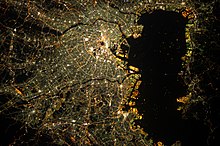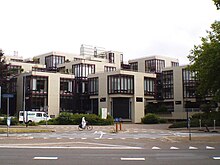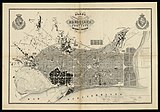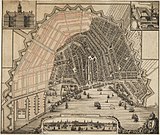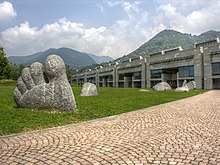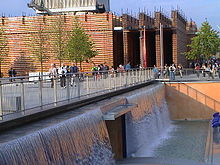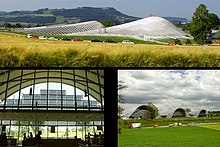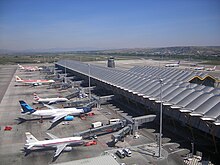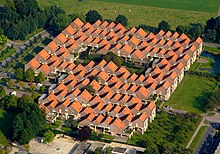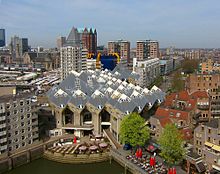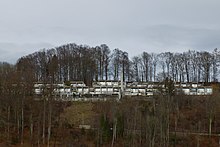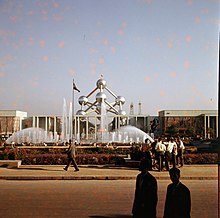Structuralism (architecture)
[3] Dutch architects of structuralism did studies in a similar way as Claude Lévi-Strauss (anthropology) and were interested in the principle "langue et parole" by Ferdinand de Saussure (linguistics), especially for the theme participation.
[5] By 1975, structuralist philosophy lost its predominant position in the humanities due to important social and political changes.
[7] The theoretical concepts of structuralism in architecture were developed mainly in Europe and Japan, with important contributions of the United States and Canada.
Important assessments concerning structuralist theory in architecture have been made by Kenneth Frampton[9] and Jürgen Joedicke [de].
[11] In this extensive book, articles by 47 international authors were published about philosophical, historical, artistic and other relevant aspects.
Surprisingly enough, the RIBA-committee did not award the Venturis with their postmodernist view, and instead, gave Herman Hertzberger the prize for his structuralist architecture and theoretical contributions.
The comment of the former RIBA president Jack Pringle was: "The Royal Gold Medal, Britain's most prestigious award, should go to an architect that has taken us forward, not backwards."
On the other hand, there is the Architecture of Lively Variety (Structure and Infill)[14] which was formulated for user participation in housing by John Habraken in 1961.
Structuralism in architecture and urban planning had its origins in the Congrès International d'Architecture Moderne (CIAM) after World War II.
[16] Outside Team 10, other ideas developed that furthered the Structuralist movement - influenced by the concepts of Louis Kahn in the United States, Kenzo Tange in Japan and John Habraken in the Netherlands (with his theory of user participation in housing).
Herman Hertzberger, Lucien Kroll and Alejandro Aravena made important architectural contributions in the field of participation.
[17] Le Corbusier created several early projects and built prototypes in a Structuralist mode, some of them dating back to the 1920s.
Although he was criticized by the members of Team 10 in the 1950s for certain aspects of his work (urban concept without a "sense of place" and the dark interior streets of the Unité), they nevertheless acknowledged him as a great model and creative personality in architecture and art.
One of the most influential manifestos for the Structuralist movement was compiled by Aldo van Eyck in the architectural magazine Forum 7/1959.
His book Supports: An Alternative to Mass Housing is the beginning of participation in architecture, as part of the structuralist movement.
Polonyi, Budapest / M. Siegler, Genf / Paul Waltenspühl [de], Genf / Hubert Hoffmann [de], Graz / Christian Farenholtz, Hamburg / Alison Smithson, London / Peter Smithson, London / Giancarlo de Carlo, Milan / Ignazio Gardella, Milan / Vico Magistretti, Milan / Ernesto Nathan Rogers, Milan / Blanche Lemco van Ginkel, Montreal / Sandy van Ginkel, Montreal / Peter Callebout [nl], Nieuwpoort / Geir Grung, Oslo / Arne Korsmo, Oslo / Georges Candilis, Paris / Aljoša Josić, Paris / André Wogenscky, Paris / Shadrach Woods, Paris / Louis Kahn, Philadelphia / Viana de Lima [pt], Porto / F. Tavora, Porto / Jacob B. Bakema, Rotterdam / Herman Haan, Rotterdam / J.M.
It is a structuralist definition in a general sense, but also the basis concept for user participation: "The fact that we put 'form' in a central position with respect to such notions as 'space' or 'architecture', means in itself no more than a shifting of accent.
What we are talking about is in fact another notion of form than that, which premises a formal and unchanging relationship between object and viewer, and maintains this.
And thus, it will be able to play as many roles as possible in the service of the various, individual users, - so that everyone will then be able to react to it for himself, interpreting it in his own way, annexing it to his familiar environment, to which it will then make a contribution."
In the architecture of Herman Hertzberger Structuralist form can be found from the smallest detail up to the most complicated structure, whether it is in terms of spatial, facade or environmental design."
At city level, important projects were: the Tokyo Bay Plan of Kenzo Tange (1960) and the fascinating images of the model of the Free University of Berlin by Candilis Josic & Woods (1963).
In general, instruments for urban structuring are: traffic lines (e.g. gridiron plans), symmetries, squares, remarkable buildings, rivers, seashore, green areas, hills etc.
In 2008, for the Triennale in Milan Alejandro Aravena built a prototype of a "Half-house" in a similar way as the Pavillon de l'Esprit Nouveau in Paris by Le Corbusier in 1925.
About the relation between historic and contemporary architecture Le Corbusier wrote: "I was labelled a revolutionary, whereas my greatest teacher was the Past.
In Forum 2/1962 Jacob Bakema made a study on the principle "reciprocity of form" and "participation", especially on the Diocletian's Palace in Split.
[20] Two years later, the themes for the new "Working group for the investigation of interrelationships between social and built structures" were published in the magazine Forum 7/1959.
[20] Themes of Team 10 on the cover of Forum 7/1959: "De Drie Hoven" for elderly people in Amsterdam-Slotervaart, 1974 (Herman Hertzberger)

